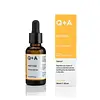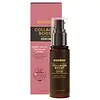What's inside
What's inside
 Key Ingredients
Key Ingredients

 Benefits
Benefits

 Concerns
Concerns

 Ingredients Side-by-side
Ingredients Side-by-side

Water
Skin ConditioningPropylene Glycol
HumectantBetaine
HumectantPentylene Glycol
Skin ConditioningXanthan Gum
EmulsifyingAloe Barbadensis Leaf Juice Powder
Skin ConditioningSodium Phytate
Glycerin
HumectantLonicera Caprifolium Flower Extract
PerfumingBiosaccharide Gum-1
HumectantLonicera Japonica Flower Extract
Skin ConditioningSodium Levulinate
Skin ConditioningTripeptide-29
Skin ConditioningSodium Hyaluronate
HumectantSodium Ascorbyl Phosphate
AntioxidantMagnesium PCA
HumectantLactic Acid
BufferingGlyceryl Caprylate
EmollientCocoyl Proline
Skin ConditioningSodium Anisate
AntimicrobialLeuconostoc/Radish Root Ferment Filtrate
AntimicrobialCitric Acid
BufferingWater, Propylene Glycol, Betaine, Pentylene Glycol, Xanthan Gum, Aloe Barbadensis Leaf Juice Powder, Sodium Phytate, Glycerin, Lonicera Caprifolium Flower Extract, Biosaccharide Gum-1, Lonicera Japonica Flower Extract, Sodium Levulinate, Tripeptide-29, Sodium Hyaluronate, Sodium Ascorbyl Phosphate, Magnesium PCA, Lactic Acid, Glyceryl Caprylate, Cocoyl Proline, Sodium Anisate, Leuconostoc/Radish Root Ferment Filtrate, Citric Acid
Maris Aqua
HumectantNiacinamide
SmoothingGlycerin
HumectantHelianthus Annuus Seed Oil
EmollientCoco-Caprylate
EmollientLysolecithin
EmulsifyingSclerotium Gum
Emulsion StabilisingXanthan Gum
EmulsifyingPullulan
Acetyl Glucosamine
Skin ConditioningSilybum Marianum Ethyl Ester
Skin ConditioningSimmondsia Chinensis Seed Oil
EmollientRosa Canina Seed Oil
EmollientDehydroacetic Acid
PreservativeBenzyl Alcohol
PerfumingSodium Hyaluronate
HumectantBisabolol
MaskingParfum
MaskingMaltodextrin
AbsorbentRubus Fruticosus Leaf Extract
MaskingPanthenol
Skin ConditioningTetrasodium Glutamate Diacetate
Tocopheryl Acetate
AntioxidantPotassium Sorbate
PreservativeAloe Barbadensis Leaf Juice
Skin ConditioningLactic Acid
BufferingPisum Sativum Extract
Skin ConditioningCyclodextrin
AbsorbentMaris Aqua, Niacinamide, Glycerin, Helianthus Annuus Seed Oil, Coco-Caprylate, Lysolecithin, Sclerotium Gum, Xanthan Gum, Pullulan, Acetyl Glucosamine, Silybum Marianum Ethyl Ester, Simmondsia Chinensis Seed Oil, Rosa Canina Seed Oil, Dehydroacetic Acid, Benzyl Alcohol, Sodium Hyaluronate, Bisabolol, Parfum, Maltodextrin, Rubus Fruticosus Leaf Extract, Panthenol, Tetrasodium Glutamate Diacetate, Tocopheryl Acetate, Potassium Sorbate, Aloe Barbadensis Leaf Juice, Lactic Acid, Pisum Sativum Extract, Cyclodextrin
Ingredients Explained
These ingredients are found in both products.
Ingredients higher up in an ingredient list are typically present in a larger amount.
Glycerin is already naturally found in your skin. It helps moisturize and protect your skin.
A study from 2016 found glycerin to be more effective as a humectant than AHAs and hyaluronic acid.
As a humectant, it helps the skin stay hydrated by pulling moisture to your skin. The low molecular weight of glycerin allows it to pull moisture into the deeper layers of your skin.
Hydrated skin improves your skin barrier; Your skin barrier helps protect against irritants and bacteria.
Glycerin has also been found to have antimicrobial and antiviral properties. Due to these properties, glycerin is often used in wound and burn treatments.
In cosmetics, glycerin is usually derived from plants such as soybean or palm. However, it can also be sourced from animals, such as tallow or animal fat.
This ingredient is organic, colorless, odorless, and non-toxic.
Glycerin is the name for this ingredient in American English. British English uses Glycerol/Glycerine.
Learn more about GlycerinLactic Acid is another well-loved alpha hydroxy acid (AHA). It is gentler than glycolic acid but still highly effective.
Its main role is to exfoliate the surface of the skin by loosening the “glue” that holds dead skin cells together. Shedding those old cells leads to smoother, softer, and more even-toned skin.
Because lactic acid molecules are larger than glycolic acid, they don’t penetrate as deeply. This means they’re less likely to sting or irritate, making it a great choice for beginners or those with sensitive skin.
Like glycolic acid, it can:
Lactic acid also acts as a humectant (like hyaluronic acid). It can draw water into the skin to improve hydration and also plays a role in the skin's natural moisturizing factor (NMF) in the form of sodium lactate.
Studies show it can boost ceramide production to strengthen the skin barrier and even help balance the skin’s microbiome.
To get results, choose products with a pH between 3-4.
Lower strengths (5-12%) focus on surface exfoliation; higher strengths (12% and up) can reach deeper in the dermis (deeper, supportive layer) to improve skin texture and firmness over time.
Though it was originally derived from milk, most modern lactic acid used in skincare is vegan. It is made through non-dairy fermentation to create a bio-identical and stable form suitable for all formulations.
When lactic acid shows up near the end of an ingredient list, it usually means the brand added just a tiny amount to adjust the product’s pH.
Legend has it that Cleopatra used to bathe in sour milk to help reduce wrinkles.
Lactic acid is truly a gentle multitasker: it exfoliates, hydrates, strengthens, and brightens. It's a great ingredient for giving your skin a smooth, glowing, and healthy look without the harshness of stronger acids.
Read more about some other popular AHA's here:
Learn more about Lactic AcidSodium Hyaluronate is hyaluronic acid's salt form. It is commonly derived from the sodium salt of hyaluronic acid.
Like hyaluronic acid, it is great at holding water and acts as a humectant. This makes it a great skin hydrating ingredient.
Sodium Hyaluronate is naturally occurring in our bodies and is mostly found in eye fluid and joints.
These are some other common types of Hyaluronic Acid:
Learn more about Sodium HyaluronateXanthan gum is used as a stabilizer and thickener within cosmetic products. It helps give products a sticky, thick feeling - preventing them from being too runny.
On the technical side of things, xanthan gum is a polysaccharide - a combination consisting of multiple sugar molecules bonded together.
Xanthan gum is a pretty common and great ingredient. It is a natural, non-toxic, non-irritating ingredient that is also commonly used in food products.
Learn more about Xanthan Gum